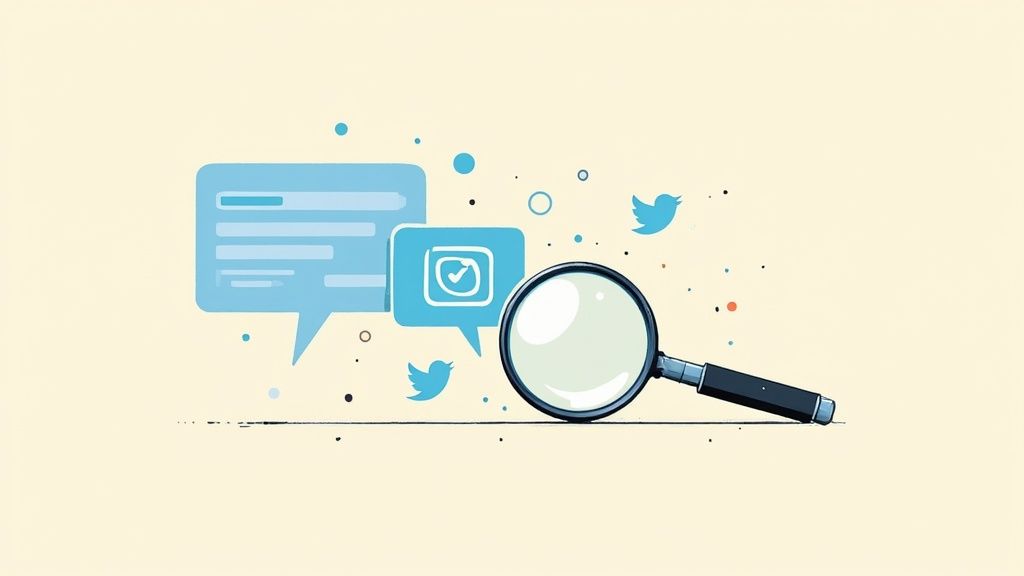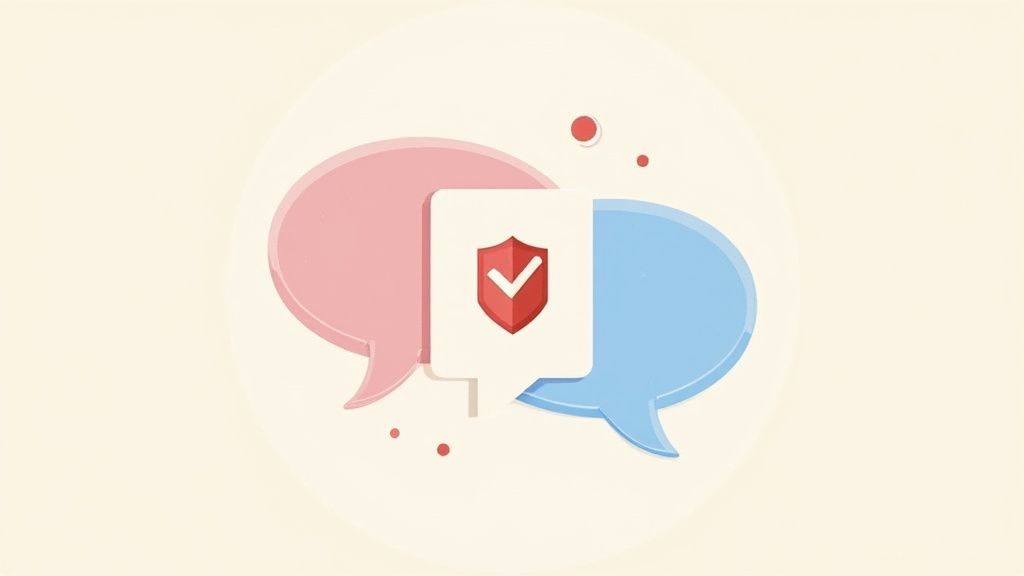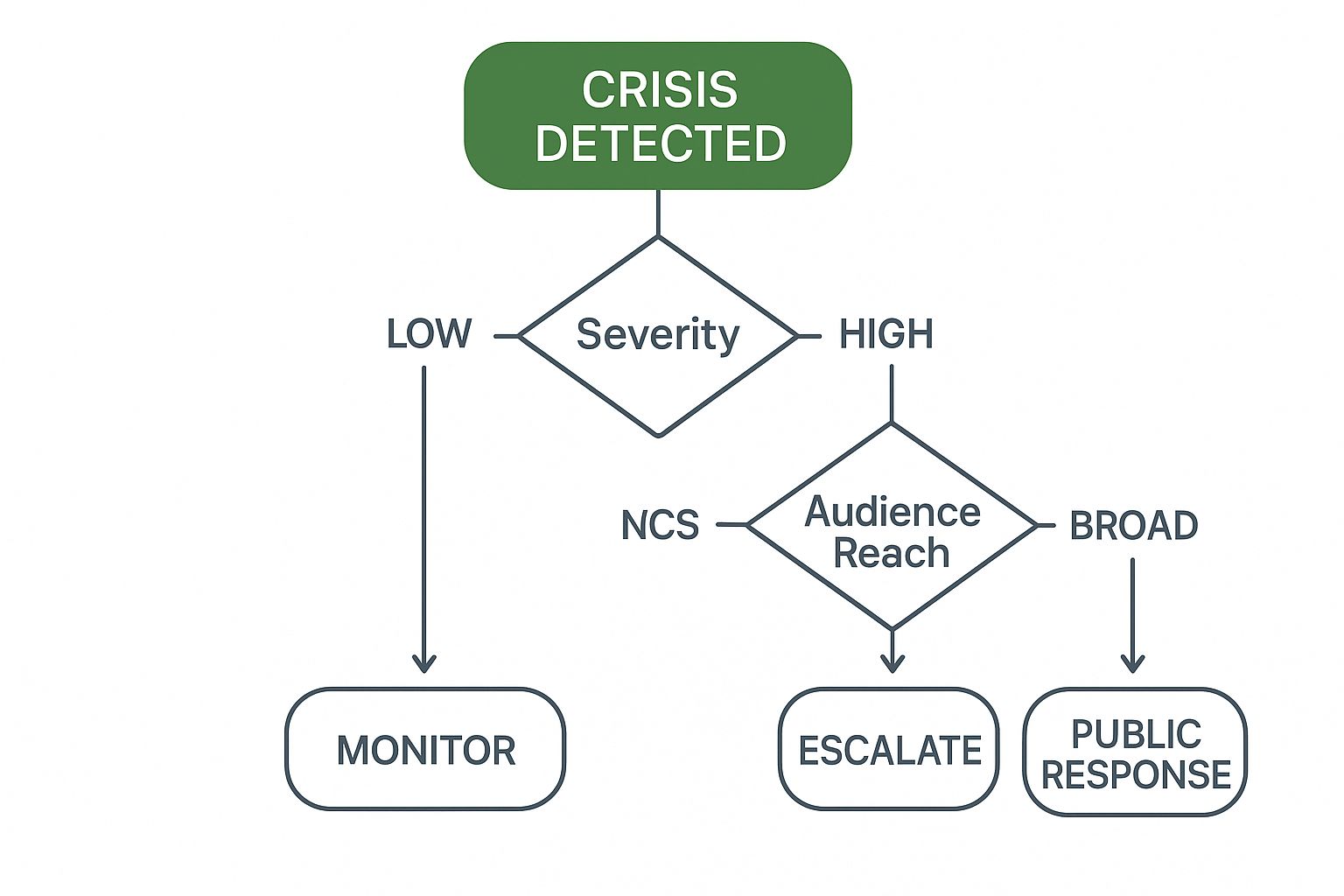Social Media Crisis Management: How to Protect Your Brand
Building Your Crisis-Ready Foundation Before You Need It

Most brands operate as if a major PR disaster is something that happens to other companies. That's a comfortable thought, but a risky one. The businesses that bounce back from a social media firestorm aren't just lucky; they’re the ones who made preparation a core part of their operations long before the crisis hit. Think of it like a fire drill—you don’t wait until you see smoke to figure out where the exits are.
The best time to lay the groundwork for social media crisis management is right now, when things are quiet. This isn't about crafting clever PR spin. It's about building a clear, repeatable system your team can follow when the pressure is on. This foundation helps you replace panic with a clear process, ensuring you can act fast when every second matters. For a broader look, this guide on effective crisis management plans has great ideas that apply to almost any industry.
Establishing Your Crisis Command Center
When a crisis hits, the last thing you want is a debate over who is supposed to do what. A well-defined command structure is your most valuable asset here. The idea is to assign roles and responsibilities with total clarity, creating a dedicated crisis team that’s ready to go at a moment's notice.
This kind of proactive setup is a hallmark of modern crisis response. Studies show that brands that prepare in advance react more quickly and effectively. A key part of this preparation is assigning specific duties—like social media monitoring, final approvals, and legal checks—to designated people. This simple step can shave precious time off your response in the critical first 30 minutes of an incident. It's also smart to draft some holding statements for common issues, like a service outage or a product recall, to avoid scrambling for words. This prep work is essential because a crisis can blow up from a single viral post in minutes. You can learn more about the strategic importance of crisis preparation and how it builds trust with your audience.
Who’s on the Team? Key Roles and Responsibilities
Having a plan is great, but a plan is only as good as the people executing it. Your crisis team should have clearly defined roles to avoid confusion and ensure all bases are covered.
- The Lead Strategist: This person, typically a senior communications or marketing leader, owns the big picture. They direct the team, make the final calls on the response plan, and ensure everyone stays on track.
- The Social Media Monitor: These are your lookouts. This person (or team) uses tools like Publora to track brand mentions, monitor sentiment, and spot a brewing crisis before it boils over.
- The Community Manager(s): As the voice of your brand, they are on the front lines. They post the approved messages, interact directly with your audience, and feed crucial on-the-ground insights back to the Lead Strategist.
- The Internal Communicator: This role keeps the rest of the company in the loop. They make sure everyone, from customer service reps to the executive team, understands the situation and the official messaging.
- The Legal/Compliance Advisor: This is your critical safety check. They review every public statement to make sure you aren't accidentally creating more legal trouble for the company.
Having these roles defined and understood ahead of time removes the chaotic "who's doing what?" scramble that paralyzes so many unprepared teams. It ensures your response isn't just fast, but also thoughtful, consistent, and safe.
To make this even clearer, here's how different roles might function based on how serious the situation is.
Crisis Team Roles and Responsibilities Matrix
This matrix outlines what each key team member should be doing as a crisis unfolds, from a minor hiccup to a major brand incident.
| Role | Low Severity | Medium Severity | High Severity | Key Skills Required |
|---|---|---|---|---|
| Lead Strategist | Monitor the situation; advise team on standby status. | Activate the crisis team; lead strategy development and approve holding statements. | Lead the full crisis response; serve as the main point of contact for executive leadership. | Strategic thinking, decisive leadership, calm under pressure. |
| Social Media Monitor | Actively track mentions and sentiment; flag any unusual spikes in volume or negativity. | Provide continuous, real-time reports on conversation trends and key influencers. | Deliver hourly (or more frequent) updates; identify misinformation and track its spread. | Analytical skills, familiarity with social listening tools, attention to detail. |
| Community Manager | Respond to individual comments using pre-approved, standard language. | Pause scheduled content; engage with the community using crisis-specific approved messaging. | Post official statements; actively manage comment sections and direct message inboxes. | Empathy, excellent communication, brand voice mastery. |
| Internal Communicator | Inform customer service and social teams about the issue and response plan. | Draft and distribute internal updates to all employees to ensure message alignment. | Manage a continuous flow of information to all internal stakeholders, including the C-suite. | Clear writing, discretion, organizational skills. |
| Legal/Compliance Advisor | On standby; provide initial thoughts if requested. | Review and approve all holding statements and public-facing responses before they go live. | Be fully embedded with the crisis team to review every piece of communication in real time. | Risk assessment, corporate law knowledge, quick decision-making. |
This table shows how each role's intensity and focus shifts with the severity of the crisis. In a low-severity event, many roles are simply on alert. But in a high-severity crisis, every role becomes critical and fully engaged. This layered approach ensures your response is always appropriate for the scale of the problem.
Spotting Trouble Before It Goes Viral

The real difference between a minor customer complaint and a full-blown PR disaster often just boils down to speed. The brands you see skillfully dodging major controversies aren't just getting lucky; they’ve built a super-sensitive early-warning system. They combine sharp human intuition with the right tech to hear the first whispers of a problem long before it turns into a roar. Great social media crisis management is much less about firefighting and more about effective fire prevention.
This means you have to move past simply tracking brand mentions. Knowing when someone talks about you is a decent start, but it's only scratching the surface. Real detection is about understanding the context and emotion fueling the conversation. Is your mention volume just ticking up, or has the general feeling shifted from neutral to angry? A single unhappy customer is one thing; a dozen people echoing the same complaint within an hour is a clear sign that something is about to catch fire.
Beyond Basic Keyword Alerts
To actually get in front of a crisis, your team needs to watch for specific, sometimes subtle, signals that trouble is on the horizon. These are the tell-tale signs that should trigger an immediate escalation.
- Sudden Spikes in Negative Sentiment: A few negative comments here and there are just part of doing business. A sudden, steep drop in positive sentiment across several platforms at once is an immediate red flag. This points to a widespread issue or a single problem that’s impacting a lot of people.
- Unusual Engagement Patterns: Is a post from six months ago suddenly flooded with angry comments? Is a small complaint getting a weirdly high number of likes and shares? These strange engagement metrics are often the first clue that an issue is picking up steam and might go viral.
- Influencer or High-Profile Mentions: The moment an account with a big, engaged following mentions your brand negatively, the potential for that message to spread grows exponentially. A single post from a respected industry figure or a popular creator can ignite a crisis in just a few minutes.
- Shifts in Conversation Themes: Are people suddenly talking about a product defect you've never heard of before? Is a new hashtag popping up that pairs your brand name with words like "fail," "scam," or "boycott"? Keeping an eye on how conversation topics evolve can show you exactly what kind of crisis is forming.
The Power of Proactive Monitoring
Using a unified dashboard is the best way to bring all this information together. Instead of jumping between different social media sites, a tool that pulls all your mentions, sentiment data, and analytics into one spot gives you a single, clear picture.
For example, a dashboard from a tool like Publora can help you see conversation volume and sentiment trends side-by-side.

This kind of visual data lets your team spot anomalies instantly, like that sudden spike in negative comments, which means you can react much, much faster.
Catching these signals early gives you back control. It buys you the precious time you need to get your crisis team together, figure out what's really going on, and put together a thoughtful response instead of just reacting defensively. It’s the difference between steering your ship away from an iceberg and launching the lifeboats after you've already hit it. Proactive monitoring is your radar, and without it, you're sailing in dangerous waters completely blind.
Crafting Crisis Responses That De-escalate Instead of Inflame

When a social media storm hits, the words you choose can either douse the flames or add fuel to the fire. Your response is your most powerful tool. Getting communication right during a crisis means finding a careful balance between speed, sincerity, and clear strategy. It’s all about knowing what to say, how to say it, and sometimes, when it’s best to say nothing at all.
This kind of communication is the backbone of effective social media crisis management. A defensive, knee-jerk reaction almost always makes the situation worse. The real goal is to acknowledge what’s happening, show you’re handling it, and steer the conversation toward a solution. It’s about responding, not just reacting. Take a breath, gather the facts, and put together a message that is both empathetic and authoritative.
The A.C.T. Framework: Acknowledge, Contextualize, Take Action
In the heat of the moment, a simple framework can be a lifesaver. Just remember to A.C.T.: Acknowledge, Contextualize, and Take Action. This approach keeps your response focused and hits the three key points your audience needs to hear.
- Acknowledge the Issue: Your first move should always be to publicly acknowledge the problem. Silence can look like guilt, indifference, or incompetence. A quick message like, "We're aware of the situation regarding [the issue] and are looking into it. We'll share an update as soon as we can," buys you valuable time and shows you're listening. This isn't an apology—it's a holding statement to stop rumors from spreading.
- Contextualize (Carefully): After you have the facts straight, you can offer some context. This isn't about making excuses; it's about being transparent. If a product malfunctioned, for example, explaining the specific component that failed is much better than a vague, corporate-sounding statement. Honesty builds back credibility.
- Take Action: This is where you really show up. Your audience wants to know what you’re doing to fix things. Are you issuing refunds? Pulling a product from shelves? Changing a company policy? Be specific about the concrete steps you are taking. Clear action demonstrates accountability and a commitment to making it right, which is essential for rebuilding trust.
Authenticity Trumps Polished Perfection
Today's audiences can spot insincere corporate jargon from a mile away. A response that sounds like it was vetted by a team of lawyers will likely do more harm than good. People connect with genuine, human communication, especially when things go wrong.
This is why having an established brand voice, a core part of your social media marketing best practices, is so important. If your brand is usually funny and informal, a sudden, stiff apology will feel off-brand and fake. Stick to your voice but adjust the tone for the seriousness of the situation. It shows that you're still the brand they know, even under pressure.
The value of a fast, transparent, and authentic response has been proven again and again. Think back to when Target had a massive data breach. The CEO appeared in a video message across social channels almost immediately. He expressed genuine regret, explained what they were doing to fix the issue, and offered free identity protection. According to O'Dwyer's, this kind of swift and authentic crisis response builds trust and helps contain the damage. The ultimate goal is to show you care more about your customers than your bottom line.
Managing the Chaos While the Storm Rages
Once a crisis kicks into high gear, your focus needs to shift from trying to prevent it to actively managing it. This stage is a marathon, not a sprint. It takes sustained focus and clear-headed decisions, even when it feels like everything is spinning out of control. The initial shock is over, but now you’re in the messy middle—this is where your social media crisis management plan really gets put to the test.
One of the toughest parts of an ongoing crisis is just keeping up with the sheer volume of information and tasks. Everything feels like a top priority, but you can't possibly do it all at once. Your first job is to separate genuine customer feedback from internet trolls who just want to stir the pot. Trolls tend to use over-the-top, generic language and aren’t interested in a real conversation. Legitimate complaints are usually specific and come from people who are truly affected. Your energy is best spent on the latter.
Prioritizing and Responding
When your social media channels are getting hammered, a triage system isn't just nice to have—it's essential. Not every comment warrants a long, personalized reply. Your team needs to categorize messages to respond effectively:
- Widespread, critical questions: Address these publicly in a central place, like a pinned post or a blog update. Your team can then link to this repeatedly. This approach saves you from typing the same answer a hundred times and keeps your messaging consistent. For some great ideas on streamlining your content, check out our guide on social media scheduling tools.
- Specific, individual problems: These need direct, empathetic responses. A personal touch can go a long way in calming down an upset customer. In some cases, using advanced tools like video customer support can add a human element that text just can't match, helping to manage individual issues with more care.
- Misinformation and rumors: Correct these quickly and with authority, but don’t get emotional. A simple, fact-based post is far more powerful than getting dragged into an online argument.
- Trolling and abuse: For the most part, just ignore or hide these comments. Engaging with trolls only gives them the attention they're looking for.
Keeping Your Internal Team Aligned
As the crisis changes, so will your response. Working with legal, PR, and leadership is vital, but it can also slow things down. Set up a simple, clear approval process. For instance, empower the social media team with pre-approved responses for common questions, only escalating new or sensitive issues to a lead strategist or legal advisor. Using a dedicated Slack or Teams channel for the crisis response team makes sure everyone has the latest information in real-time, which helps prevent mixed messages.

This model illustrates that not every problem needs an immediate, all-hands-on-deck public statement. It helps your team use its resources where they matter most.
Ultimately, riding out the storm is about staying in control of your communications and your team’s actions. It’s about being thoughtful and strategic when your gut might be screaming at you to react to every little thing. By prioritizing your responses, streamlining how your team communicates, and focusing on solving real problems, you can steer your brand through the turbulence without getting lost.
The Real Economics of Crisis Management Investment
Talking about the budget for a crisis that hasn’t happened yet can feel a bit abstract, almost like planning for a rainy day when the sun is shining. But here's the thing: smart organizations see social media crisis management as a crucial investment, not just another line item on the expense sheet. Ignoring the potential fallout from a reputation disaster is like building a house in a flood zone without insurance—the cost of being unprepared will always sting more than the cost of prevention. You end up paying one way or another: either proactively through planning or reactively through damage control, lost sales, and a tarnished brand.
The numbers don't lie. The market for professional help in this arena is booming for a good reason. Globally, the social media crisis management industry has grown to an estimated USD 3.5 billion. This isn't just one type of service; it covers everything from crisis communication and reputation management to specialized monitoring tools. Demand is so high that crisis communication services alone are projected to grab over 26% of this market by 2037. You can dig deeper into this growing market and its implications for businesses. The trend is clear: treating crisis readiness as a core business function is the new standard.
Finding the Right Investment Level for Your Brand
So, what does this actually mean for your budget? There’s no one-size-fits-all answer. Your investment really depends on your company's size, industry, and overall risk profile. A global consumer brand is playing a different game than a local B2B service provider, and their budgets should reflect that.
Here’s a general idea of the options out there:
- DIY Monitoring Tools: For small businesses or even solo creators, a powerful monitoring tool like Publora is often the most practical first step. It gives you an "early-warning system" to track sentiment and brand mentions, letting a small team catch trouble before it blows up.
- Boutique PR & Crisis Firms: Mid-sized companies might find value in keeping a specialized agency on retainer. These firms can help you build a crisis plan, run drills with your team, and offer expert advice the moment an issue pops up.
- Full-Service Enterprise Solutions: Large corporations with a massive public footprint often need a more hands-on approach. Full-service crisis management firms provide everything from 24/7 monitoring and strategic counsel to actively managing a crisis from start to finish.
Building the Business Case for Preparedness
Getting the green light from executives means framing this as a value-protector, not just another cost. The ROI isn’t only about preventing a stock dip; it's about avoiding all the hidden costs. Think about the opportunity cost of your entire marketing team being pulled into damage control for weeks. What about the long-term dent in customer loyalty or the higher cost of winning new customers after trust has been shattered?
When you make your case, pitch it as risk versus reward. The investment in a solid plan and the right tools is a tiny fraction of the potential losses in revenue, market share, and brand equity. By preparing now, you're not just buying a service—you're securing your brand's future.
Rebuilding Trust and Emerging Stronger
The flood of negative comments might have slowed to a trickle, and the media has likely found its next headline, but this is where your most important work truly begins. The recovery phase of social media crisis management is a marathon, not a sprint. It takes more patience, strategy, and consistent effort than the initial fire-fighting. Every move you make is under a microscope, and progress is measured in small, hard-won bits of trust. Turning a crisis into an opportunity isn't about luck; it's about a deliberate, long-term commitment to showing you've changed.
Think of it like mending a broken bone. The sharp, initial break gets all the attention, but it's the slow, careful process of healing and physical therapy that actually rebuilds strength. After a PR crisis, you have to methodically show your audience that you didn’t just hear their concerns—you’ve fundamentally changed because of them.
From Listening to Learning
Your first job is to shift from reactive monitoring to proactive listening. During the crisis, you were watching mentions to manage the immediate chaos. Now, you’re listening to understand the lasting damage and find a path toward forgiveness. This calls for a more subtle approach:
- Sentiment Recovery Tracking: Keep a close eye on your brand's sentiment score. Is it slowly climbing back to where it was before the crisis? Are there still pockets of negativity? Tools like Publora can help you see these trends over weeks and months, highlighting where you still need to focus your efforts.
- Identifying Advocates: Look for the people defending your brand or acknowledging your efforts to make things right. These are your first allies in recovery. Engaging with them and sharing their positive messages can help shift the public conversation.
- Learning from Lingering Criticism: Don't write off the people who are still angry. Their ongoing criticism often contains the most valuable lessons. Are they pointing out a flaw in your recovery plan? Did your apology miss the mark with a certain group? Use their feedback to fine-tune your strategy.
This diagram shows the typical stages a company goes through during a crisis.
As the model illustrates, the "Post-crisis" stage is all about learning and resolution. This is vital for preventing future issues and making a full recovery.
Demonstrating Real, Tangible Change
Apologies are words, but actions are proof. The public has a long memory for corporate promises, so you have to follow through with concrete, visible changes. This is your moment to show, not just tell, your audience that you’ve learned from the mistake.
For instance, if the crisis was caused by a faulty product, your recovery content could include behind-the-scenes videos of your new quality control process. If it was a customer service disaster, you could launch a new training program for your team and publicly share its goals. You need to prove that the lessons have been woven into your company's DNA.
This also means changing how you measure success for a while. Your focus might shift from sales-driven metrics. Instead, as we cover in our guide on choosing the right social media KPIs, you should prioritize metrics like positive sentiment, engagement on your recovery-focused content, and trust scores from customer surveys.
Ultimately, coming out stronger after a crisis is entirely possible, but the path is paved with humility, transparency, and a relentless focus on action. It's about earning back trust one customer, one post, and one positive change at a time. Brands that manage this don't just survive; they build a more resilient reputation and a more loyal community than they had before the storm.
Your Crisis Management Action plan
Knowing the theory is a great start, but it won’t do much when your brand’s reputation is tanking in real time. True social media crisis management is all about having a clear, practical plan your team can follow when the pressure is on. It's time to turn all this knowledge into a solid roadmap you can use today.
Your Immediate To-Do List
To get things moving, let’s focus on a few foundational tasks. This isn’t everything, but getting these done will put you in a much better place to handle whatever comes your way.
- Assemble Your Crisis Team: Officially decide who is on your crisis response team. Clearly define their roles—from the person leading the strategy to the community manager on the front lines—and create a contact sheet. Make sure everyone has accepted their role and knows exactly what’s expected of them.
- Draft Holding Statements: You can’t predict every single crisis, but you can anticipate the types of problems that might pop up. Go ahead and write some pre-approved holding statements for common situations like service outages, product defects, or negative news about an employee. Having these ready to go saves precious time when minutes count.
- Establish a Central Hub: Set up a private channel in Slack or Microsoft Teams just for your crisis team. This will be your command center for sharing updates, assigning tasks, and getting approvals without getting lost in endless email chains.
Defining Your Core Processes
Once your team is in place and you have some basic templates, it's time to map out your process. Beyond the social media details, a strong incident management process is the backbone of any crisis plan. This means setting clear triggers for when the plan gets activated and creating a simple flowchart for who needs to approve communications.
The idea is to shift from being reactive to being prepared. Don't wait for a real fire to see if your fire extinguisher works. Run a small-scale drill with your team. Give them a made-up scenario and have them walk through the action plan. This is the single best way to find any weak spots in your strategy before they become major problems.
This proactive approach is what separates the brands that bounce back from a crisis from those that don't. Ready to get ahead of the chaos? Publora’s powerful monitoring and management tools can serve as the foundation of your crisis action plan. Start your 14-day free trial today and build your brand's defense system.
